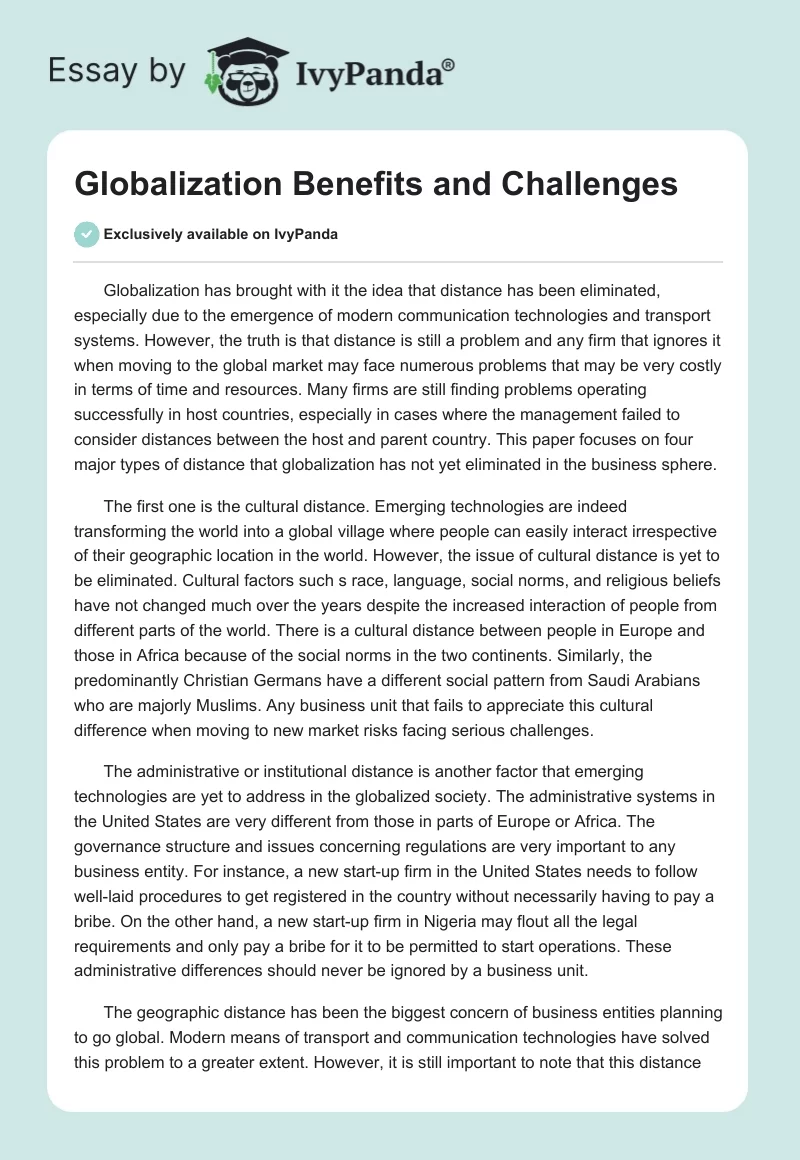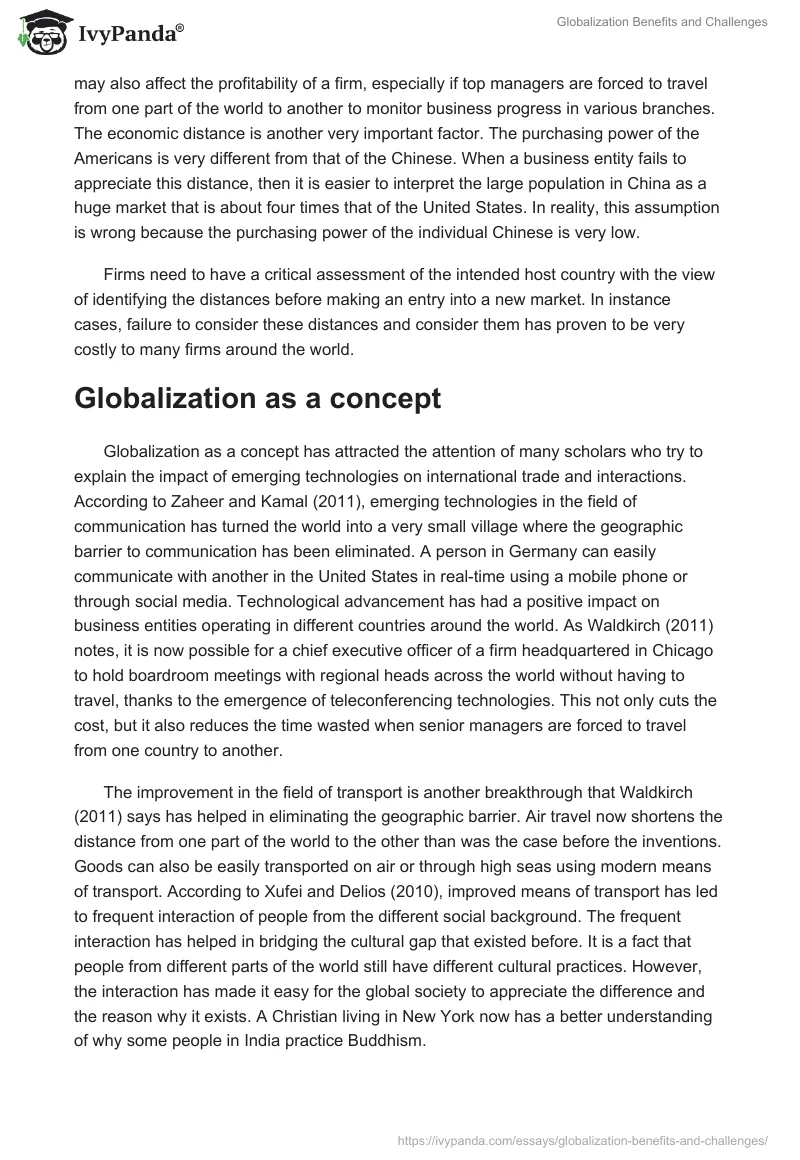Globalization has brought with it the idea that distance has been eliminated, especially due to the emergence of modern communication technologies and transport systems. However, the truth is that distance is still a problem and any firm that ignores it when moving to the global market may face numerous problems that may be very costly in terms of time and resources. Many firms are still finding problems operating successfully in host countries, especially in cases where the management failed to consider distances between the host and parent country. This paper focuses on four major types of distance that globalization has not yet eliminated in the business sphere.
The first one is the cultural distance. Emerging technologies are indeed transforming the world into a global village where people can easily interact irrespective of their geographic location in the world. However, the issue of cultural distance is yet to be eliminated. Cultural factors such s race, language, social norms, and religious beliefs have not changed much over the years despite the increased interaction of people from different parts of the world. There is a cultural distance between people in Europe and those in Africa because of the social norms in the two continents. Similarly, the predominantly Christian Germans have a different social pattern from Saudi Arabians who are majorly Muslims. Any business unit that fails to appreciate this cultural difference when moving to new market risks facing serious challenges.
The administrative or institutional distance is another factor that emerging technologies are yet to address in the globalized society. The administrative systems in the United States are very different from those in parts of Europe or Africa. The governance structure and issues concerning regulations are very important to any business entity. For instance, a new start-up firm in the United States needs to follow well-laid procedures to get registered in the country without necessarily having to pay a bribe. On the other hand, a new start-up firm in Nigeria may flout all the legal requirements and only pay a bribe for it to be permitted to start operations. These administrative differences should never be ignored by a business unit.
The geographic distance has been the biggest concern of business entities planning to go global. Modern means of transport and communication technologies have solved this problem to a greater extent. However, it is still important to note that this distance may also affect the profitability of a firm, especially if top managers are forced to travel from one part of the world to another to monitor business progress in various branches. The economic distance is another very important factor. The purchasing power of the Americans is very different from that of the Chinese. When a business entity fails to appreciate this distance, then it is easier to interpret the large population in China as a huge market that is about four times that of the United States. In reality, this assumption is wrong because the purchasing power of the individual Chinese is very low.
Firms need to have a critical assessment of the intended host country with the view of identifying the distances before making an entry into a new market. In instance cases, failure to consider these distances and consider them has proven to be very costly to many firms around the world.
Globalization as a concept
Globalization as a concept has attracted the attention of many scholars who try to explain the impact of emerging technologies on international trade and interactions. According to Zaheer and Kamal (2011), emerging technologies in the field of communication has turned the world into a very small village where the geographic barrier to communication has been eliminated. A person in Germany can easily communicate with another in the United States in real-time using a mobile phone or through social media. Technological advancement has had a positive impact on business entities operating in different countries around the world. As Waldkirch (2011) notes, it is now possible for a chief executive officer of a firm headquartered in Chicago to hold boardroom meetings with regional heads across the world without having to travel, thanks to the emergence of teleconferencing technologies. This not only cuts the cost, but it also reduces the time wasted when senior managers are forced to travel from one country to another.
The improvement in the field of transport is another breakthrough that Waldkirch (2011) says has helped in eliminating the geographic barrier. Air travel now shortens the distance from one part of the world to the other than was the case before the inventions. Goods can also be easily transported on air or through high seas using modern means of transport. According to Xufei and Delios (2010), improved means of transport has led to frequent interaction of people from the different social background. The frequent interaction has helped in bridging the cultural gap that existed before. It is a fact that people from different parts of the world still have different cultural practices. However, the interaction has made it easy for the global society to appreciate the difference and the reason why it exists. A Christian living in New York now has a better understanding of why some people in India practice Buddhism.
To the business world, Hahn, Doh, and Bunyaratavej (2009) warn that it is still dangerous for a firm to assume that improved means of transport and communication systems is a sign of elimination of the existing barriers. Indeed, a Saudi national may now understand and even appreciate Christian practices, but that may not necessarily make him abandon his Islamic culture. In a business context, it means that if such a person was not eating pork before, the new knowledge may not change his mind when it comes to the issue of eating pork. The administrative distance has not been changed much over the years despite the globalization frenzy that has hit the world over the past decade. Germans are still holding to their tradition of a highly formal business environment where people must follow well-laid policies despite the interaction with the United States where the emphasis is laid on mutual respect and a semi-formal workplace environment. These are some of the important facts that many businesses ignore when going global. They wrongly believe that continued interaction between two countries may mean cultural assimilations. Roy and Oliver (2009) also say that the issue of the language barrier is still affecting many firms that try to go global. Since the number of active languages in the world continues to shrink, this factor is still a major barrier to entry into some markets.
The case study about Wal-Mart
The case study about Wal-Mart demonstrates that failure to understand various distances that exists between the host country and the parent country before going global may lead to a series of losses to a firm. Wal-Mart has been thriving on its ‘everyday low price’ policy in the United States, but this model could not be successfully transferred to Germany because of the legal restrictions. There are limits below which a firm can set its price for any given product. The law prohibits setting prices for a product lower than its actual cost, a requirement that does not exist in the United States. The business model of Wal-Mart has been successful in the United Kingdom and North America because the cultural distance in these regions is increasingly getting smaller.
Many American retailers who move to Germany find it difficult to deal with the cultural distance. Other than the language barrier, buyer behavior in Germany is very different from that in the United States. For instance, it is a common practice for a shopper to move from one retailer to another picking different items based on the pricing of different stores. This is very different from what happens in the United States where people mostly prefer doing their entire shopping under-one-roof. Wal-Mart indeed overestimated the transferability of its FSA when it was moving to Germany, and this explains its failure to prosper. As Zaheer and Kamal (2011) note, Wal-Mart has become very cautious when moving to new markets. Since its shameful exit from the German market, Wal-Mart has focused on expanding its operations within the United States (Verbeke 2013).
List of References
Hahn, E, Doh, J & Bunyaratavej, K 2009, ‘The Evolution of Risk in Information Systems Off-shoring: The Impact of Home Country Risk’, Firm Learning, and Competitive Dynamics, MIS Quarterly, vol. 33, no. 3, pp. 597-616.
Roy, J & Oliver, C 2009, ‘International Joint Venture Partner Selection: The Role of the Host-Country Legal Environment’, Journal of International Business Studies, vol. 40, no, pp. 779-801.
Verbeke, A 2013, International business strategy: Rethinking the foundations of global corporate success, Cengage Learning, New York.
Waldkirch, A 2011, ‘Comparative advantage FDI: A host country perspective’, Review of World Economics, vol. 147, no. 3, pp. 485-505.
Xufei, M & Delios, 2010, ‘Host-country headquarters and an MNE’s subsequent within-country diversifications’, Journal of International Business Studies, vol. 41, no. 3, pp. 517-525.
Zaheer, A & Kamal, D 2011, ‘Creating trust in piranha-infested waters: The confluence of buyer, supplier and host country contexts’, Journal of International Business Studies, vol. 42, no. 1, pp. 48-55.


